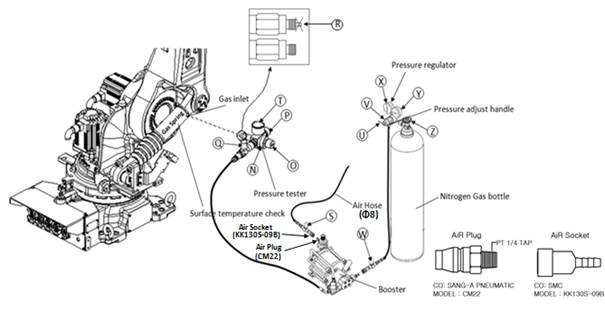9.2.2. When the nitrogen bottle pressure is 150 bar or below (Replenishing the gas by using the booster)
9.2.2. When the nitrogen bottle pressure is 150 bar or below (Replenishing the gas by using the booster)
(1) Set the H axis of the robot at the 90 ° posture, and cut off the power to the controller.
(2) Remove the plug installed in the gas inlet of the spring.
(3) Check if the bleed value Pand shutoff valve Q of the pressure tester are closed (Clockwise lock).
(4) Turn the knob Ocounterclockwise so that the release pin R does not protrude.
(5) Turn the knob N of the pressure tester clockwise to connect it to the gas inlet completely.
(6) Check whether the handle U, shutoff valve ⓦ, knob ⓢ (the knob of the air hose owned by the customer), and the shutoff valve are closed.
(7) Connect the regulator connection part screw to the nitrogen bottle screw.
(Each connection part of the hoses should be connected to each connection inlet)
Since the specification of the nitrogen bottle screw varies among countries, be sure to purchase a regulator that can meet the specification of the nitrogen bottle screw.
(8) The gauge X indicates the target gas pressure of the nitrogen bottle, and the gauge Y indicates the pressure of the nigrogen bottle.
(9) Open the knob Z of the nitrogen bottle and turn the handle of the regulator to set the target gas pressure (The targe gas pressure is the designated in the “Table 9-1 Table of the pressure for each surface temperature of the gas spring”).
(10) Open the shutoff valve ⓦ of the hose connected to the regulator V, and turn the shutoff value Q, which is to be connected to the pressure tester, counterclockwise slowly until the pointer of the pressure gauge T and the pointer of the gauge X are matching.
(11) Connect the air hose connection part to the booster, and then open the knob ⓢ (the knob of the air hose owned by the customer). Then, the booster will operate.
Fill the gas until the pointer of the pressure gauge Treaches the target pressure.
※ The minimum air pressure for the filling process is 5 bar or higher.
Replace the nitrogen bottle when the residual pressure of the bottle is below 30 bar or lower.
(12) If the target pressure is reached, close the shutoff valve Q and open the bleed valve Pto release the residual pressure inside the pressure tester.
(Do not loosen the bleed value P by turning it 360˚ or more)
(13) Close the bleed valve P. While turning the knob O clockwise slightly, check whether the pointer of the pressure gauge Tmatches with the target pressure. If it is confirmed that they are matching, stop turning it.
Take precautions not to let the release pin R go inwards excessively, causing damage to the valve mounted to the gas spring.
(14) If the pressure exceeds the target pressure, adjust the gas pressure to the desired level by opening and closing the bleed valve Pslightly.
(15) Turn the knob Ocounterclockwise to retract the release pin R.
(16) When the pressure is checked, open the bleed valve P to completely release the residual pressure inside the pressure tester.
(17) Lock the knob ⓢof the air hose and disconnect it from the booster.
(18) Close the shutoff valve ⓦ of the hose connected to the regulator and lock the handle U.
(19) Lock the knob Z of the nitrogen bottle and disconnect the hose connected to the regulator V from the booster and open the shutoff valve ⓦ to release the residual pressure inside.
(20) Disconnect the shutoff connection part from the pressure tester.
(21) Turn the knob N of the pressure tester counterclockwise to disconnect it from the gas spring.
Fasten the G1/8 plug to the gas spring.
Once the gas is filled, please use it after waiting for about 30 minutes for the temperature to return to the level of the room temperature.

Figure 9.3 Replenishing the gas of the gas spring by using the booster
Depending on the type, the gas replenishing kit and the booster may have a different shape and name. Please refer to the manual enclosed when purchasing the kit |